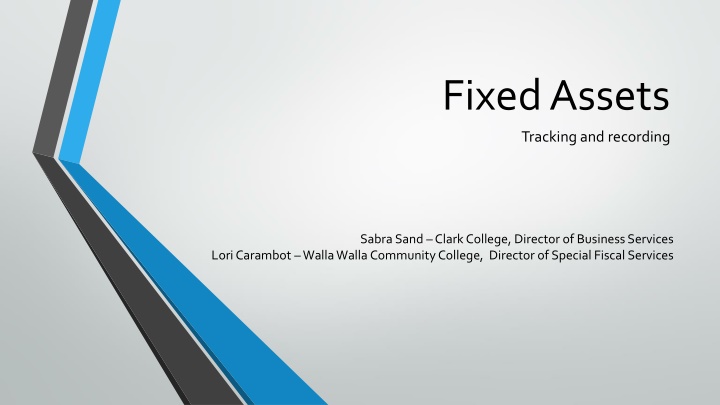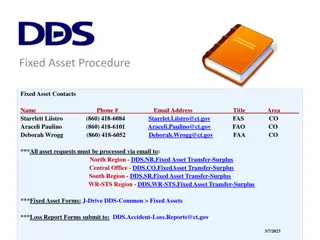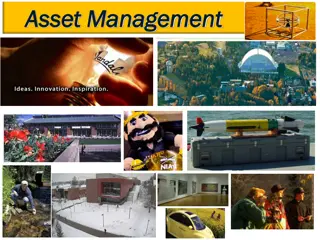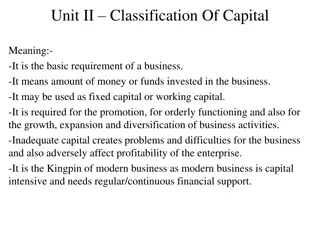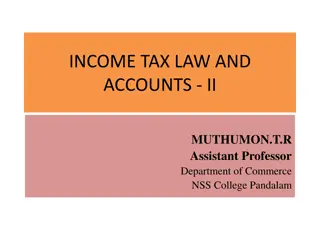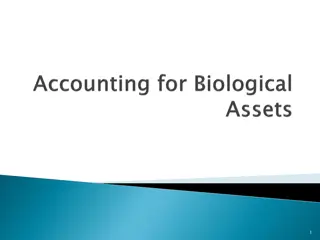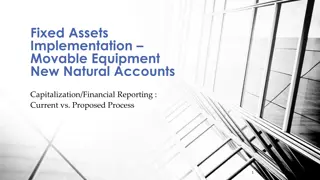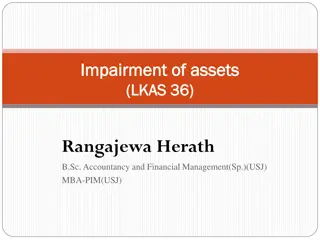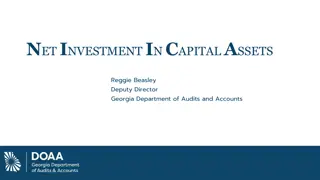Comprehensive Fixed Assets Management Guidelines for Educational Institutions
Explore a detailed guide on tracking and recording fixed assets in educational institutions, covering key aspects such as capital assets accounting procedures, general ledger accounts, and the definition of capital assets. Learn the minimum standards for valuing assets, recording guidelines, and the classification of various asset types. Enhance your understanding of managing fixed assets efficiently and accurately in a university setting.
Uploaded on Sep 13, 2024 | 4 Views
Download Presentation

Please find below an Image/Link to download the presentation.
The content on the website is provided AS IS for your information and personal use only. It may not be sold, licensed, or shared on other websites without obtaining consent from the author.If you encounter any issues during the download, it is possible that the publisher has removed the file from their server.
You are allowed to download the files provided on this website for personal or commercial use, subject to the condition that they are used lawfully. All files are the property of their respective owners.
The content on the website is provided AS IS for your information and personal use only. It may not be sold, licensed, or shared on other websites without obtaining consent from the author.
E N D
Presentation Transcript
Fixed Assets Tracking and recording Sabra Sand Clark College, Director of Business Services Lori Carambot Walla Walla Community College, Director of Special Fiscal Services
Guides and Policies Fiscal Affairs Manual 40.20 OFM SAAM Manual Chapter 30 OFM SAAM Manual Chapter 85.60 Capital Assets Accounting Procedures and Illustrative Entries
Guideline Highlights These are the minimum standards for fixed assets (SAAM) Capital assets are valued at acquisition cost including delivery, taxes and any costs for setup/installation less any trade discount amounts If self-constructed assets and debt is acquired to finance, add in any interest paid during the construction All ancillary costs are included such as surveys, appraisals, site prep, sales tax, delivery/shipping (not feasibility studies or preliminary work) Donated assets valued at the estimated acquisition value General Assets are recorded in Fund 997 Fixed Assets belonging to Internal Service Funds and Enterprise funds are recorded in their respective funds Never record fixed assets in agency funds Don t delete assets All assets purchased through COPs must be capitalized
General Ledger Accounts 2110 Land 2140 Intangible Assets (non-land) with Indefinite Useful Lives 2210 Buildings 2220 Allowance for Depreciation Building 2310 Improvements Other than Buildings (Infrastructure) 2320 Allow for Depr. IOTB 2410 Furnishings and Equipment 2420 Allow for Depr. Furn. & Equip.
(General Ledger Accounts cont.) 2430 Library Resources 2440 Allow for Depr. Library Resources 2470 Intangible Assets with Definite Useful Lives 2480 Allowance for Amortization = Intangible Assets 2510 Construction in Progress
Capital Assets (FAM 40.20) Definition: Long-lived assets of a relatively fixed or permanent nature, tangible, and not held for resale. Capable of repeated use and expected to last more than a year. Acquired through donation, purchase, capital lease or construction
Capital Lease (40.20.10a) Definition: Leases that transfer all the benefits and risks inherent in ownership of an asset where the title will eventually be owned by the college. One or more of the following must be met: By the end of the lease, ownership is transferred to the college The lease contains a bargain purchase option Lease is equal to 75% of the estimated useful life of the leased asset. Would require prior approval by GA and OFM If at the inception of the lease, the present value of the minimum lease payments excluding executory costs is 90% or more of the FV of the asset. Executory costs are usually insurance, maintenance, and taxes If these conditions are not met, it is considered an operational lease (record as ED or EH sub-object)
Useful Life Use the SAAM Commodity Code table found at SAAM 30.50 This is a 4-digit code that defines the type and useful life of a capitalized fixed asset Do not use 0500 for buildings use the o5xx where xx indicates useful life
Fixed Asset Valuation & Recording
Land Never depreciated If purchased with a building must separate land component from building component
Buildings Will only depreciate if cost is greater than $100,000 Included in Cost Loading docks Heating and air conditioning equipment Refrigeration equipment All other permanently attached that are integral parts of the structure Cost of preparing the site, such as demolition Additions to a building are included if they exceed $100,000 Additions, replacements or extraordinary repairs ONLY if they extend the life of the building, increase capacity, or substantial improvement in quality of output or reduction in operating costs. (30.20.20.c) Replacements if greater than $100,000 and at least 10% of replacement value of the asset Not Included Furniture and fixtures Movable equipment Roof Repair/Replacements Floor covering replacements HVAC system repair/replacement
Improvements Other than Buildings (IOTB) Permanent improvements to the land Commodity code 06xx (xx is the number of years to depreciate) Examples roads, sidewalks, parking lots, outside lighting, solar projects, wind projects, storm or sewer water systems Capitalize only if value is $100,000 or greater Replacements if greater than $100,000 and at least 10% of replacement value of the asset (examples in SAAM)
Equipment Value greater than $5,000 Value includes sales tax, transportation/shipping, site prep, and installation Trade-ins the NBV of the asset traded in is added to the cost of the replacement item to determine the total amount to capitalize for the new asset (SAAM 85.60.50) Donated equipment if estimated fair market value is $5,000 or greater this will be a reconciling item between FMS and DirectLine Small and Attractive Need policy to define Need a system to inventory May be attached to a building but capitalized separately unless it is integral to the building
Library Resources Not restricted by dollar value Entered at year end as an aggregate amount
Small and Attractive Must be marked/tagged and identified Must be recorded and inventoried Subject to physical inventory counts Perform a risk assessment to determine at risk items or classes of items Should have a written policy for S&A SAAM 30.40.30 Guns, firearms and accessories must always be included If no written policy then: Laptops, notebooks, tablets and smartphones with cost over $300 Optical devices, binoculars, telescopes, cameras, desktop computers, TVs, DVD/Blu-ray players and video cameras with cost over $1,000 must be inventoried
Recording Assets in FMS Detailed Transaction Codes can be found in FAM 40.20.60 Process different in Government vs Proprietary Funds
Depreciation Recorded in same fund as asset See FAM 40.20.70 for transaction codes
Disposals FAM 40.20.80 At year end, don t net disposals and acquisitions
Inventory Inventory officer issues tags when new items are received Sequential and destroyed tags should be documented Physical inventory is to be conducted Can be revolving or specific point in time During inventory watch for items that possibly should be tagged but are not Written inventory instructions are required and are to include How and where items are to be counted and information to be recorded Who to ask if there is a question What procedures are to be followed Count sheets are to be signed as attestation
Year end disclosure Schedule E
Reports Capital Asset Activity to the State for CAFR disclosure Use the CR2128 and Year end fixed asset entries Important to keep acquisition and disposal entries separate Increases and decreases in both acquisition/disposal and depr for acquisitions and disposals need to be recorded and reported separately
